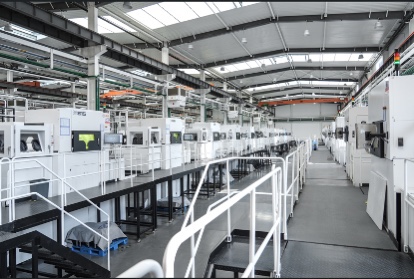As if to deliberately draw attention to the fact that we are in a new Cold War era, the Chinese government has formally announced that it, like the US, will make this issue a priority. In a meeting of China’s State Council last Friday, “a guideline on accelerating the development of advanced manufacturing clusters” was debated and ultimately adopted. Part of this acceleration, perhaps, is the 163,200 square meter metal 3D printing plant that Xi’an Bright Laser Technologies Ltd (BLT) recently broke ground on.
Biden’s Advanced Manufacturing Hubs
One recurring central feature of the Biden administration’s grand strategy for US industry is its focus on geographically organizing the nation into regional advanced manufacturing clusters. I’ve mentioned this frequently in recent posts, primarily concerning its significance to arguably the two largest potential future markets for the additive manufacturing (AM) sector: clean energy, and semiconductors.
For instance, this is essentially the entire premise behind the $72 million in Department of Energy (DOE) funding that was recently announced, which is going towards Centers of Excellence (COEs) for the DOE’s Industrial Assessment Centers (IACs). As established by the Bipartisan Infrastructure Law, there are now five COEs which will serve as central hubs for the IACs in each of their respective regions, with the regions being Great Plains, Southeastern, Mid-Atlantic, Gulf Coast, and Western.

Moreover, in the National Strategy for Advanced Manufacturing that the Biden administration released in October, 2022, it states, “To address these [supply chain] vulnerabilities and improve supply chain decision-making at all levels, technology hubs and industrial clusters should be expanded and better connected so that they can effectively utilize common information platforms and market intelligence. Federal agencies are uniquely positioned to organize, mobilize, and communicate strategic intelligence to provide early warning to the nation’s supply chain about prospective cyberthreats, supply chain shocks, and geopolitical risks. Manufacturing entities must also use shared knowledge to improve resilience to the effects of climate change and understand the effects of increasing weather disturbances, coastal and inland flooding, wildfires, and more on their suppliers, customers, and distribution networks.”
China’s Advanced Manufacturing Clusters

Much as in the US, the Chinese State Council plan is most particularly focused on electric vehicle (EV) charging infrastructure. And, because virtually every major market is dependent on the semiconductor supply chain — and perhaps the EV market more than any other outside of things like PCs and gaming consoles — this will also inevitably impact the semiconductor industry in China.
Interestingly, despite the nominally different political systems in the US and China, and the supposed decoupling of the two nations’ economies, the concept of ‘advanced manufacturing clusters’ is now common currency in the world’s two largest military powers. This seems especially noteworthy considering the fact that, as yet, there do not seem to be any real world examples of fully-fledged advanced manufacturing clusters.
Nevertheless, they are now apparently the central grounds on which the new Cold War is organizing itself. In that case, not only can they be expected to spring into existence at record speeds, but they are also destined to emerge more or less simultaneously everywhere outside the US and China, as well.
Aside from the multitude of other major implications, one especially important one for businesses in the AM sector is that it serves as a reminder that establishing local and regional connections is just as important as establishing global and national ones. From now on, it will likely be even more important, as digital infrastructure is inherently already set up to make transnational and global business links easy. For businesses, it can often take far more effort at this point to forge ties with their local communities, as effective networking in this case is much more likely to require good old fashioned, in-person cooperation.
Subscribe to Our Email Newsletter
Stay up-to-date on all the latest news from the 3D printing industry and receive information and offers from third party vendors.
You May Also Like
3D Printing Unpeeled: New Arkema Material for HP, Saddle and Macro MEMS
A new Arkema material for MJF is said to reduce costs per part by up to 25% and have an 85% reusability ratio. HP 3D HR PA 12 S has been...
3D Printing News Briefs, January 20, 2024: FDM, LPBF, Underwater 3D Printer, Racing, & More
We’re starting off with a process certification in today’s 3D Printing News Briefs, and then moving on to research about solute trapping, laser powder bed fusion, and then moving on...
3D Printing Webinar and Event Roundup: December 3, 2023
We’ve got plenty of events and webinars coming up for you this week! Quickparts is having a Manufacturing Roadshow, America Makes is holding a Member Town Hall, Stratafest makes two...
Formnext 2023 Day Three: Slam Dunk
I’m high—high on trade show. I’ve met numerous new faces and reconnected with old friends, creating an absolutely wonderful atmosphere. The excitement is palpable over several emerging developments. The high...































